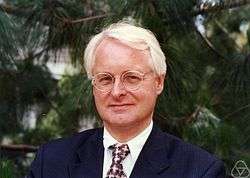Hendrik Lenstra
| Hendrik Lenstra | |
|---|---|
 Hendrik W. Lenstra Jr. | |
| Born |
16 April 1949 Zaandam, Netherlands |
| Nationality | Dutch |
| Alma mater | University of Amsterdam |
| Scientific career | |
| Fields | Mathematics |
| Institutions |
University of California, Berkeley University of Leiden |
| Doctoral advisor | Frans Oort |
| Doctoral students |
Daniel J. Bernstein René Schoof William A. Stein |
Hendrik Willem Lenstra Jr. (born 16 April 1949, Zaandam) is a Dutch mathematician.
Biography
Lenstra received his doctorate from the University of Amsterdam in 1977 and became a professor there in 1978. In 1987 he was appointed to the faculty of the University of California, Berkeley; starting in 1998, he divided his time between Berkeley and the University of Leiden, until 2003, when he retired from Berkeley to take a full-time position at Leiden.
Lenstra has worked principally in computational number theory and is well known as the discoverer of the elliptic curve factorization method and a co-discoverer of the Lenstra–Lenstra–Lovász lattice basis reduction algorithm. The Cohen-Lenstra heuristics, a set of precise conjectures about the structure of class groups of quadratic fields, is named after him.
Three of his brothers, Arjen Lenstra, Andries Lenstra, and Jan Karel Lenstra, are also mathematicians. Jan Karel Lenstra is the former director of the Netherlands Centrum Wiskunde & Informatica (CWI). Hendrik Lenstra was the Chairman of the Program Committee of the International Congress of Mathematicians in 2010.[1]
Awards and honors
In 1984 Lenstra became member of the Royal Netherlands Academy of Arts and Sciences.[2] He won the Fulkerson Prize in 1985 for his research using the geometry of numbers to solve integer programs with few variables in time polynomial in the number of constraints.[3] He was awarded the Spinoza Prize in 1998,[4] and on 24 April 2009 he was made a Knight of the Order of the Netherlands Lion. In 2009, he was awarded a Gauss Lecture by the German Mathematical Society. In 2012 he became a fellow of the American Mathematical Society.[5]
Publications
- Euclidean Number Fields. Parts 1-3, Mathematical Intelligencer 1980
- Factoring integers with elliptic curves. Annals of Mathematics, vol. 126, 1987, pp. 649–673
- with A. K. Lenstra: Algorithms in Number Theory. pp. 673–716, In Jan van Leeuwen (ed.): Handbook of Theoretical Computer Science, Vol. A: Algorithms and Complexity. Elsevier and MIT Press 1990, ISBN 0-444-88071-2, ISBN 0-262-22038-5.
- Algorithms in Algebraic Number Theory. Bulletin of the AMS, vol. 26, 1992, pp. 211–244.
- Primality testing algorithms. Séminaire Bourbaki 1981.
- with Stevenhagen: Artin reciprocity and Mersenne Primes. Nieuw Archief for Wiskunde 2000.
- with Stevenhagen: Chebotarev and his density theorem. Mathematical Intelligencer 1992 (Online at Lenstra's Homepage).
- Profinite Fibonacci Numbers, December 2005, PDF
See also
References
- ↑ ICM – International Congress of Mathematicians
- ↑ "Hendrik Lenstra". Royal Netherlands Academy of Arts and Sciences. Retrieved 19 July 2015.
- ↑ Past winners of the Fulkerson Prize, retrieved 2015-07-18.
- ↑ "NWO Spinoza Prize 1998". Netherlands Organisation for Scientific Research. 11 September 2014. Retrieved 30 January 2016.
- ↑ List of Fellows of the American Mathematical Society, retrieved 2013-01-27.
- Prof. dr. H.W. Lenstra, 1949 - at the University of Amsterdam Album Academicum website
External links
- "Cryptocoinnews.com speculation that Lenstra might be Satoshi Nakamoto".
- "Home Page: Emeritus professor, Department of Mathematics, University of California, Berkeley".
- "Hendrik W. Lenstra". , Homepage at the Leiden Mathematisch Instituut
- Hendrik Lenstra at the Mathematics Genealogy Project